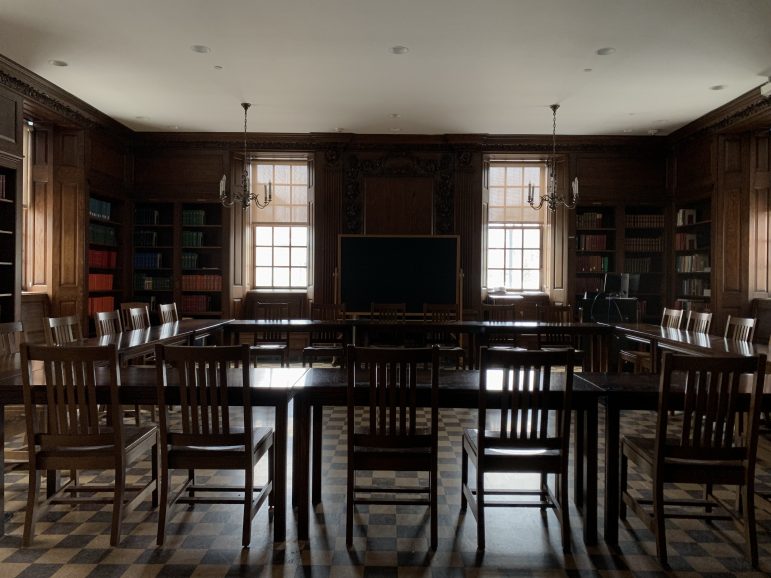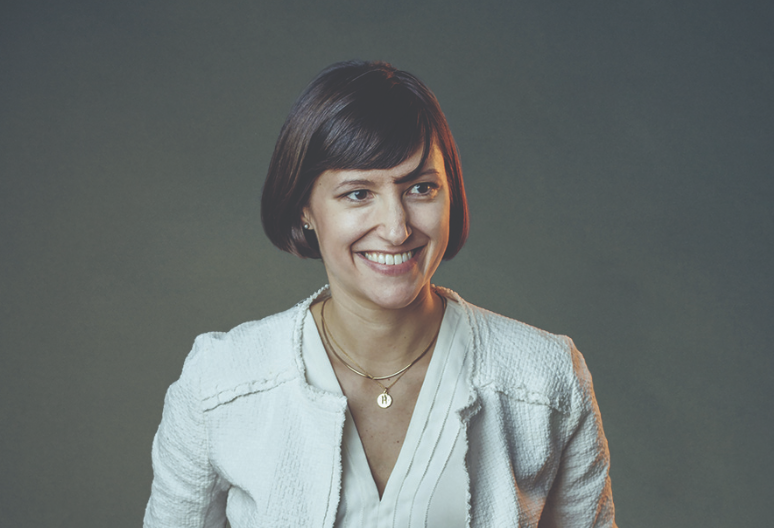Professors approach remote learning with creativity, cautious optimism
April 3, 2020

Imagine you are a Williams professor. You care deeply for your students. You try to develop a high-quality, intellectually invigorating experience. But the College has shut down, and a pandemic threatens the world. You’re at home, perhaps with a child or two to take care of, and an elderly parent to worry about. Your only teaching tools are online — Zoom, Glow, Piazza — but you’ve never taught online.
For Associate Professor of Biology Matt Carter, it feels like it is his first time teaching all over again.
“We’re all nervously trying to find out how it’s all going to work,” he said.
Tempered by a healthy dose of realism, faculty across departments are approaching the transition to remote learning with creativity and cautious optimism. They wish it didn’t have to be this way, and are glad it is only temporary, but have risen to the challenge with solutions ranging from 3D models of fossils to innovative ways of keeping students’ attention.
“To be honest, I’m really optimistic,” Carter said. “Ever since the decision to go to remote learning, I’ve seen nothing but faculty trying their best, and I’m not just saying this to be generous to my colleagues.”
“I think they’re just different things,” said Associate Professor of Geosciences Phoebe Cohen, referring to online and in-person courses. “One of the things we’ve been saying at Williams a lot is that we’re not doing online courses; we’re doing remote teaching. We’ve been using that vocabulary to distinguish the fact that our courses were not designed to be online, and that people spend years developing online courses.”
Professors have chosen to approach remote learning in many different ways. Most of the professors who spoke with the Record emphasized the difficulty of generalizing the way their colleagues are choosing to teach.
“Just like in-person teaching, there’s not one right way to do it,” Carter said.
In addition, with traditional teaching models out the window, faculty who have been teaching for years now find themselves on uncertain footing.
Those in the Office of Institutional Technology (OIT) have been instrumental in making the transition to remote learning smooth, according to Carter.
“They have all been heroes,” he said. “They’ve really given us a sense of confidence, too.”
All of the professors who spoke with the Record emphasized the work OIT has done, which included making a Glow page for faculty to discuss remote teaching options and share advice, holding Zoom office hours every day of the week and hosting two faculty showcases for different online teaching techniques.
Chief Information Officer Barron Koralesky added that this support was a collaboration of the Academic Resources Center, Office of the Dean of the Faculty, OIT and the Library.
Professor of Mathematics Chad Topaz, who is currently on leave, has also been helping faculty transition to remote learning, since he has experience teaching online courses. He cautioned against drawing a sharp dichotomy between in-person and online teaching.
“Just like when you teach an on-the-ground class, when you’re teaching an online class, you should always think about learning goals,” he said. “When we say the word ‘online teaching,’ the tendency is to jump to the technology, like, ‘Should I use Zoom or should I use this other thing?’ It sort of becomes about the tool, but whether a tool is a good or bad thing is a highly contextual thing.”
He urged professors to view teaching online through the lens of human learning.
“[Learning] is your goal,” he said. “These are the things people are doing to do the information dump part of teaching; these are the things people are doing to do the discussion-y part of learning; these are the things people are doing for the one-on-one interaction.”
So what are professors going to do, exactly? How do you teach someone to paint over Zoom? To design experiments? To analyze fossils?
Professor of Art Laylah Ali, who teaches “Introduction to Oil Painting,” has adapted by mailing her students acrylic paint and other necessary tools, all paid for by the College. The class had to switch to acrylic paint because oil paints require a space with proper ventilation to be used safely.
“I take this unideal situation as a creative challenge, though I am generally not a proponent of spending this much time online,” Ali wrote in an email to the Record.
Along with switching to acrylic paint, there are other drawbacks to remote learning for Ali’s class.
“In-person is much better for learning things that require nuance, color, gesture, and consideration of the entire body,” she wrote.
Cohen and Sarah Goh, chair and professor of chemistry, are attempting to teach concepts online that are normally learned through labs. Because they cannot replicate the lab experience entirely, they are focusing on learning goals — an approach that Topaz also drew attention to.
In the chemistry department, labs are valuable in two ways, Goh said. One is reinforcing content and fostering actual skills in the lab, which they will teach through videos and simulations. The other is the “art of experimentation and the ability to try (and fail),” Goh said. These develop critical thinking and creativity.
Along with relying on videos, some of which the chemistry department filmed itself, Goh is also using a former chemistry student’s lab notebook.
“As much as possible, we’re trying to give the students ‘real’ data to analyze. In CHEM 156 [Organic Chemistry: Introductory Level], for example, we have data from a former chemistry student,” Goh wrote. “She left her notebook behind and, in an example of good record keeping, we are able to use her amounts of starting materials and boiling points to provide students with values that they likely would have recorded if they were on campus.”
For her class on paleobiology, there are abundant data on rocks and fossils online, Cohen said.
“There are a lot of museums that have started digitizing their collections, and some of them have 3D models of fossils, like 3D scans of fossils that you can rotate and zoom in on your computer,” she said.
More difficult to adapt, though, was an upper-level class that Cohen had planned to take on a trip to Utah to collect specimens, which they would spend the rest of the semester writing papers about. Instead, they will also rely on online databases, which the class spent the first half of the semester learning how to use.
Carter has also been thinking deeply about ways to keep his class engaged.
“I’ve experimented with a lot of different things,” he said. “I think that every faculty member I know has experimented with different platforms, and everyone is trying to figure out what the tool is for their particular course.”
He landed on PowerPoint because of its interactivity.
“I like the idea that students have to click to keep going,” he said. “Everybody knows what it’s like to watch a video. The video can keep playing whether you’re paying attention or not, or you can make yourself a sandwich or fold your laundry.”
Pure curiosity, he decided, will be the primary method for keeping his students engaged in a learning environment without grades or in-person, synchronous classes.
He said he might end his PowerPoint lectures by asking, “How do you think so-and-so works, and give them some things to think about, and so then they are gonna want to go to the next online content — kind of like a Netflix show.”
“End on a cliffhanger,” he added, laughing.
The transition has also made him reflect on his own in-person teaching practices. He said that he will emphasize curiosity even more than he had before.
“I took it for granted just how meaningful it is to see somebody,” he said. “When I was experimenting with online tools, I realized that there’s actually something really important about being able to see your professor — like actually, physically see them and know that they’re there even if they’re not there with you.”
In Division II, Chair and Professor of History Anne Reinhardt said the transition has mostly been easier than for her colleagues who teach classes with labs.
“In history, much of what we do — not all of it — is more classroom-based, discussion-based and those kinds of things, I think, have fewer logistical problems to moving online,” Reinhardt said.
But she has colleagues teaching courses on material culture and rare books, which have a “really important experiential component,” which is “much harder to duplicate in an online experience,” she said.
Chair and Professor of English Kathryn Kent ’88 said duplicating the English experience might be difficult.
“Especially in a discipline such as English, so much happens through discussion — replicating that experience is going to be hard,” she wrote in an email to the Record.
But she did recognize potential positives — with a caveat.
“What on-line learning might provide that regular classes do not: a focus on writing and on more self-directed challenges,” she wrote. “An opening up of old models. New forms of intellectual community. But I would be kidding myself if I thought it was going to be as successful as what I usually do.”
As professors consider how to best serve their students, several asked that students think of their professors’ circumstances as well.
“Just remember, your faculty are people too who are dealing with the same anxieties, and struggles and stresses,” Cohen said. “Many of us have children at home who we’re trying to take care of at the same time as doing our teaching.”







